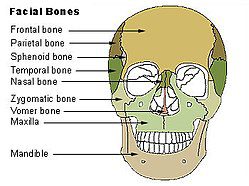Contents
Vomer
The vomer (from the Latin vomer, meaning ploughshare of the plow) is a bone contained in the bony structure of the head at the level of the facial skull.
The vomer and the other bones of the skull
Position. The vomer is a median bone located in the posterior and lower part of the nasal cavity1.
Structure. The vomer is a thin bone in the facial skull, one of the two parts of the skull. Ovoid in shape and comprising eight bones, the facial skull forms the eye sockets, nasal cavities and oral cavity (1) (2).
joints. The vomer is articulated with:
- The ethmoid bone, bone of the cerebral skull, located above and behind;
- The sphenoid bone, bone of the cerebral skull, located at the back;
- Palatine bones, facial skull bones, located below;
- Maxillary bones, facial skull bones, located in front.
Function of the vomer
Respiratory tracts. Given its position and its structure, the vomer allows the formation of the nasal cavities, involved in the respiratory tract.
Pathologies associated with the vomer bone
Different pathologies can affect the bones of the skull, including the vomer bone. These conditions can be caused by malformations, deformations, degenerative diseases or even trauma.
Cranial injuries. The skull can suffer trauma in the form of cracks or fractures. In some cases head damage can be accompanied by brain damage.
- Crack of the skull. The crack is the lightest lesion but should be watched to avoid any complications.
- Skull fracture. The skull can suffer from fractures at the base of the skull, especially at the level of the vomer.
Bone pathologies. Bone pathologies can occur in the vomer.
- Paget’s disease. This bone disease is defined by an acceleration of bone remodeling. Symptoms are bone pain, headaches, and cranial deformities3.
- Bone tumors. Benign or malignant tumors can develop at the base of the skull4.
Headache (headache). A frequent symptom in adults and children, it manifests as pain in the forehead. There are many causes of a headache. A doctor can be consulted in case of sharp and sudden pain.
- Migraine. A particular form of headache, it often begins with very localized pain and manifests itself in seizures.
Treatments
Medical treatment. Depending on the pathology diagnosed, certain medications may be prescribed such as painkillers, anti-inflammatories or antibiotics.
Surgical treatment. Depending on the pathology diagnosed and its evolution, a surgical intervention may be performed.
Chemotherapy, radiotherapy or targeted therapy. Depending on the type and stage of the tumor, these treatments may be used to destroy cancer cells.
Bone exams
Physical examination. The causes of forehead pain can be diagnosed by simple clinical examination.
Imaging exams. In some cases, additional examinations may be performed such as cerebral CT scan or cerebral MRI.
History
In 2013, researchers published in the scientific journal Science the analysis of a complete skull discovered in Dmanisi in Georgia. Dating from around 1,8 million years ago, this skull is believed to be one of the first representatives of the genus Homo outside Africa5. This discovery could provide additional information on the structure of the skull over the course of evolution.










